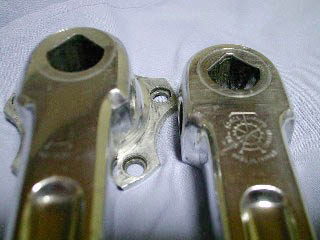A week ago, I was pedaling Tosca, my Mercian fixed gear bike, along the very northern tip of Manhattan. I had no destination in mind: I was simply enjoying a ride on an unseasonably warm day.
Just before the Broadway Bridge, I stopped for a light. So did a fellow crossing the intersection from my left. I couldn't help but to notice what he rode:
We greeted each other. "Don't see that bike very often," I exclaimed.
Bill bought it, and another just like it in another color--yellow--in Princeton, from a Craigslist ad. The person who sold it told him it came from a shop in that town.
It was most likely Kopp's, I told him. At the time the bike was made--the early '70's, from what I could see--Kopp's was one of the few shops where one could have bought that bike. It was one of the few shops that sold high-quality bikes before the '70's Bike Boom; even as the popularity of bikes surged, it was one of the few places that stocked Schwinn Paramounts and the bike in the photo.
It's a Schwinn Sports Tourer, second in Schwinn's line after the Paramount. The Sports Tourer was the re-incarnation, if you will, of the Superior, which was made in 1962-63. The model in the photo was made in 1971, the first year Schwinn made the Sports Tourer--which became the Superior in 1976.
The bike Bill rode, like other Sports Tourers and Superiors, was built around a frame constructed from filet-brazed Chrome-molybdenum tubing. The workmanship is quite nice: the joints are very smooth and rounded.
Ironically, those joints are probably the reason the Sport Tourer and Superior didn't sell well. Bike books and magazines published at the dawn of the Bike Boom claimed, almost unanimously, that high-quality lightweight bikes had lugged frames. The brass filets brazed around the joints of bikes like the Sport Tourer and Superior served the same purpose as lugs and, like lugs, made it possible to use thinner gauges of tubing than those used on welded frames.
But those bikes made for nice touring and even all-arounder bikes. Bill replaced the wheels and derailleurs that came with his bike, as well as the handlebar stem. But he kept the Specialites TA crankset, which he meticulously cleaned and polished.
He also kept another TA item: the handlebar bag, which LaFuma made for TA. That bag and crank--and the Brooks B15 saddle-- are almost worth what he paid for the bike!
We enjoyed a pleasant ride into Westchester County and back into the Bronx, chatting about our bikes and lives along the way. After our ride, he sent me photos of his other bikes. He has quite the collection, including an early Schwinn Super Sport--which replaced the Superior in 1964 and became Schwinn's third-line bike when the Sports Tourer came out in 1971.
Perhaps we will ride together again--he, on one of his other bikes, perhaps, and me on one of mine.
Just before the Broadway Bridge, I stopped for a light. So did a fellow crossing the intersection from my left. I couldn't help but to notice what he rode:
We greeted each other. "Don't see that bike very often," I exclaimed.
Bill bought it, and another just like it in another color--yellow--in Princeton, from a Craigslist ad. The person who sold it told him it came from a shop in that town.
It was most likely Kopp's, I told him. At the time the bike was made--the early '70's, from what I could see--Kopp's was one of the few shops where one could have bought that bike. It was one of the few shops that sold high-quality bikes before the '70's Bike Boom; even as the popularity of bikes surged, it was one of the few places that stocked Schwinn Paramounts and the bike in the photo.
It's a Schwinn Sports Tourer, second in Schwinn's line after the Paramount. The Sports Tourer was the re-incarnation, if you will, of the Superior, which was made in 1962-63. The model in the photo was made in 1971, the first year Schwinn made the Sports Tourer--which became the Superior in 1976.
The bike Bill rode, like other Sports Tourers and Superiors, was built around a frame constructed from filet-brazed Chrome-molybdenum tubing. The workmanship is quite nice: the joints are very smooth and rounded.
Ironically, those joints are probably the reason the Sport Tourer and Superior didn't sell well. Bike books and magazines published at the dawn of the Bike Boom claimed, almost unanimously, that high-quality lightweight bikes had lugged frames. The brass filets brazed around the joints of bikes like the Sport Tourer and Superior served the same purpose as lugs and, like lugs, made it possible to use thinner gauges of tubing than those used on welded frames.
But those bikes made for nice touring and even all-arounder bikes. Bill replaced the wheels and derailleurs that came with his bike, as well as the handlebar stem. But he kept the Specialites TA crankset, which he meticulously cleaned and polished.
He also kept another TA item: the handlebar bag, which LaFuma made for TA. That bag and crank--and the Brooks B15 saddle-- are almost worth what he paid for the bike!
We enjoyed a pleasant ride into Westchester County and back into the Bronx, chatting about our bikes and lives along the way. After our ride, he sent me photos of his other bikes. He has quite the collection, including an early Schwinn Super Sport--which replaced the Superior in 1964 and became Schwinn's third-line bike when the Sports Tourer came out in 1971.
Perhaps we will ride together again--he, on one of his other bikes, perhaps, and me on one of mine.








































